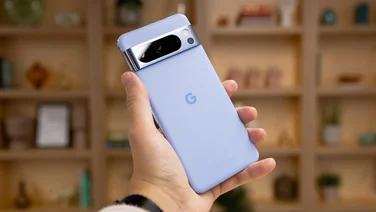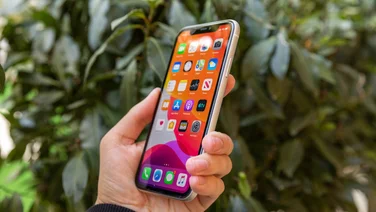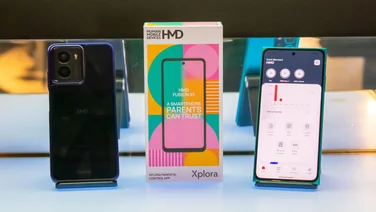To help us provide you with free impartial advice, we may earn a commission if you buy through links on our site. Learn more
- Google Pixel 9 review: What you need to know
- Google Pixel 9 review: Price and competition
- Google Pixel 9 review: Design and key features
- Google Pixel 9 review: Display
- Google Pixel 9 review: Performance and battery life
- Google Pixel 9 review: Software
- Google Pixel 9 review: Cameras
- Google Pixel 9 review: Verdict


















- Excellent 6.3in OLED screen
- Very accomplished cameras
- Some impressive AI tricks
- Second consecutive £100 price bump
- Performance way short of the best
- New design is solid but less distinctive than before
Google’s Pixel smartphone lineup has become something of a safe recommendation for anyone who wants a classy all-rounder but doesn’t want to pay equivalent iPhone money. However, the price has been creeping up in recent years, and this year’s Google Pixels continue that trend.
The base Pixel 9 has a lot going for it, with a sharp new design, great cameras and clever AI-infused software. However, is it really worthy of yet another £100 price bump – especially with the Pixel 8a doing ostensibly similar things for just £499?
Google Pixel 9 review: What you need to know
Google’s flagship phones have expanded this year, with a second-generation foldable (the Pixel 9 Pro Fold) and a brand-new compact flagship (confusingly called the Pixel 9 Pro) joining the team alongside the Pixel 9 Pro XL. It’s the Pixel 9 that will be of interest to most people, however, thanks to a more accessible price – although it’s not as accessible as it used to be.An expanded 6.3in OLED display has been added to this year’s model, housed in a revamped design that cribs from the Apple playbook. The sides of the Pixel 9 are now flat, while the signature width-spanning Pixel visor has morphed into a standalone (but still very wide) camera module.
Google has souped up the internal components, too, with a new Tensor G4 processor, 12GB of RAM (up 50% on the Pixel 8) and a larger 4,700mAh battery. The main camera is the same 50MP (f/1.7) unit as before, but the ultrawide lens uses an improved 48MP sensor. The selfie camera is broadly the same 10.5MP (f/2.2) unit as before, but now with autofocus.
In its haste to bring the Pixel 9 to market, Google was unable to ship it with Android 15, which will arrive shortly after launch. This means that it comes with Android 14, just like the Pixel 8 series. You do get a stack of new AI tricks, however, and there’s the same generous seven-year update promise.
Google Pixel 9 review: Price and competition
Our primary complaint about the Pixel 8 was that it was £100 more expensive than the Pixel 7, but it still felt like good value compared to its contemporaries. Now the Pixel 9 has added yet another £100 premium on top, and Google can no longer claim “bargain flagship” bragging rights.
With a starting price of £799 for the 128GB model, the Pixel 9 is now exactly the same price as the Samsung Galaxy S24 and the iPhone 15 and must be judged on those steeper terms. Indeed, the step-up 256GB model with 256GB of storage costs £899, which is £50 more than the equivalent Samsung model.
In short, Google’s mainstream flagship phone has lost a major point of difference over its key rivals. It’s a risky thing taking them on in this way, especially as the Pixel brand remains far behind iPhone and Galaxy in terms of sales and brand awareness. This could well be a make or break year for Google’s smartphone hardware business.
READ NEXT: Best smartphone
Google Pixel 9 review: Design and key features
Google can at least partially justify the price rise with a brand-new design. Gone are the Pixel 8’s gently curved edges and tightly curved corners, and in their place come flattened-out sides and a more gradual curvature to the four extremities. All of which is an elaborate way of saying that it looks a lot like an iPhone 15, and by extension the Samsung Galaxy S24. I’m genuinely disappointed to see Google moving to this me-too approach, especially as the Pixel aesthetic was so distinctive.


















There’s some reprieve on the back of the phone, though the signature Pixel camera visor has also gone. It no longer melts into the frame but is a standalone camera module. Thankfully, it still nods to its Pixel heritage by running across most of the width of the phone, and its symmetrical nature means that the phone sits solidly on flat surfaces.


















Both the screen and rear glass material have stepped up to Gorilla Glass Victus 2, which means they’re more scratch-resistant than the Pixel 8, while the body is still formed from aluminium. Google has stuck with a matte finish on the frame and a shiny coating on the back, which I prefer to the Pixel 9 Pro’s reflective frame and matte back on balance. While Porcelain and Obsidian cover your standard white and black options, Peony (pink) and Wintergreen (green) bring a dash of colour, should you wish it.


















This is a slightly thinner phone than its predecessor at 8.5mm, but it’s also a tad heavier at 198g. It feels solid and premium in the hand, while a more uniform bezel goes some small way to justifying that £100 price bump. An IP68 rating makes a return, too, so the Pixel 9 remains resistant to water and dust ingress.
Google Pixel 9 review: Display
Google has ramped things up on the display front, increasing the size of its OLED display from 6.2in to 6.3in. You get a similar 2,424 x 1,080 resolution, which proves plenty sharp enough at this size, though it’s less sharp than the identically sized Pixel 9 Pro screen.
Unlike the Pro, Google doesn’t give you a lower resolution by default. Conversely, you can’t drop it down with the aim of saving battery life. You still get a 120Hz refresh rate, though this isn’t an LTPO panel, so it can’t be finessed down to 1Hz when the screen content requires less fluidity.
Google has greatly cranked up the brightness of its screen, however. With auto-brightness turned off I measured a maximum luminance of 1,172cd/m2, which is significantly brighter than both the Samsung Galaxy S24 and the iPhone 15.


















The quality of the Pixel 9 screen is also exceptional, despite being a lesser component than the Pro. Switching away from the default Adaptive mode to the more consistent Natural setting I recorded an average Delta E of 0.68 when tested against sRGB, with gamut coverage of 99.8% and a total volume of 103%.
READ NEXT: Best mid-range phone
Google Pixel 9 review: Performance and battery life
Google has supplied its latest Tensor G4 chipset for the Pixel 9, which is exactly the same component as the one used in the more expensive Pixel 9 Pro range. It has also fitted the phone out with 12GB of RAM, which is a 50% bump over the Pixel 8 and Pixel 7. The most likely reason for this is Google’s increasing focus on AI features, which are notoriously memory-hungry.
The resulting performance is a step up from the Pixel 8, but not a huge one. Our benchmark tests reveal a fairly modest bump in both CPU and GPU terms. More starkly, the Pixel 9 isn’t even a match for the Samsung Galaxy S23 on any of our usual tests, let alone the Samsung Galaxy S24.
Any contemporary Android phone running on a Snapdragon 8 Gen 3, such as the Xiaomi 14 or the OnePlus 12, absolutely obliterates the Pixel 9 using traditional performance metrics. Make no mistake, the Pixel 9 is the runt of the flagship litter when it comes to pure processing power. It’s always been thus, but it was something we could let slide when Google’s phone was also cheapest in its class. No longer.
Battery life is much more impressive. In our standard looping video test, the Pixel 9 lasted just over 26hrs 20mins, which is about an hour longer than the Pixel 8. In terms of its direct rivals, this is an hour less than the Galaxy S24, but six hours longer than the iPhone 15.
In general terms, I found that a 14-hour day of pretty heavy usage (around five hours and 45 minutes of screen-on time) still left me with more than 40% to play with, which is a strong result for a compact flagship. Indeed, I found the Pixel 9 to have slightly better stamina than the Pixel 9 Pro in everyday operation.
The charging provision continues to max out at a somewhat slow 27W. Using a 30W Asus charger (Google doesn’t include one of its own in the box), I managed to get the Pixel 9 from empty to 55% in 30 minutes. That’s a tad better than the Samsung Galaxy S24, but falls way short of the OnePlus 12 and the Xiaomi 14.
READ NEXT: Best phone battery life
Google Pixel 9 review: Software
Because Google announced the Pixel 9 range two months earlier than usual, the latest version of Android isn’t ready to ship with it. This means that the Pixel 9 runs on Android 14 at launch, just like the Pixel 8 did ten months earlier. It’s not an ideal situation, but it remains a brilliantly clean and crisp OS a year on, and you’ll still be getting Android 15 and many more Android versions courtesy of Google’s industry-leading seven-year update promise.
Besides, Google has bigger AI-generated fish to fry. The big software additions to the Pixel 9 are all AI-related, including Gemini AI being installed as the default personal assistant in place of Google Assistant. Yet this is something of a mixed blessing in my experience. Google’s sophisticated AI chatbot can converse with you using natural language, compose a series of thank you messages to your mother, or come up with a snappy itinerary for a weekend city break.


















What it can’t do is some of the more prosaic stuff, such as playing music from a particular artist on my YouTube Music account. It frequently gets confused when I make vocal requests of my Nest speakers, even when the Pixel 9 is in another room entirely. Google Assistant was much dumber, but it was also a mature tool and thus better integrated. Gemini is getting better and better but, like Android 15, it’s perhaps not quite ready for prime time.
Elsewhere, Pixel Studio is a new app that’s both very clever and pretty pointless, unless you’re someone who dreams of adding bespoke stickers and custom image attachments to your messages. It can generate images based on freewheeling text inputs. I typed in “pixel art video game of a wild boar holding an umbrella”, and sure enough, Pixel Studio turned out exactly that image.


















The Pixel Screenshots app – labelled here simply as “Screenshots” – represents the inverse of Pixel Studio, in that it sounds pretty boring on paper, but is really useful in practice. It uses AI to sift through the information captured in your screenshots, then generates summaries of the contents and makes them searchable. You can also sort them into collections and add notes.
Google Pixel 9 review: Cameras
The Pixel 9 has the same 50MP (f/1.7) 1/1.31in main camera as the Pixel 8, which also happens to be the exact same sensor used in the Pixel 9 Pro range. It also has the same 48MP (f/1.7) 1/2.55in ultrawide camera as the Pro series, which represents a welcome upgrade on the Pixel 8. Ultrawide shots broadly maintain the tone of the main sensor and now pack more detail, if a slightly narrower 123-degree angle.
Indeed, the only thing that the Pixel 9 lacks compared to its Pro brothers is a dedicated telephoto camera and the more impressive 42MP selfie camera. You’ll have to make do with the old 10.5MP front-facing unit, though the addition of autofocus represents a significant upgrade, with a more natural, locked-on focus.

Throw in the improved image processing from Google’s new Tensor G4, and the Pixel 9 takes fabulous photos in all lighting conditions. There’s a definite look to Pixel shots, which tend to be extremely sharp and contrasty. They never stray into garish territory – unless you specifically want them to.
The Pixel 9 provides you with excellent fire-and-forget shots, but also a vast suite of powerful AI-driven editing tools should you wish to tinker. Google’s Magic Editor is now scarily powerful, with a Reimagine feature that lets you play with the reality depicted in the shot. Insert a chihuahua into the foreground, change the background from a grey English harbour to a balmy tropical port (complete with palm trees) or even swap out that ugly building in the background for a giant marshmallow. If you can think of it, you can type it into Reimagine, and your shot will be transformed in a variety of ways – some convincing, some outright broken.


Personally, I find this level of AI intervention to be completely against the spirit of photography, which surely is to capture real-life moments as precisely as possible. But there’s no denying how impressive these tools are.
Another new camera feature is Add Me, which lets the taker insert themselves into a group shot. It works really well in technical terms, with a handy preview guide ensuring that the two shots line up cleanly, and the results often look extremely convincing. Given my previous comments about capturing the moment, however, you can probably guess whether I’ll be adopting this feature into my own photography.

Google’s image-processing wizardry has always been best put to use in simply making demanding shots look and feel easy, even those that would stretch the capabilities of dedicated high-end cameras. The Pixel 9 does that better than ever, with night shots looking startlingly clear and crisp for the most part, though a few hints of noise in dark sky areas suggests that it could perhaps stand to lean into the blackness of night a little more. Google is a master of HDR, too, preserving highlights and shadows alike.

Zoomed-in shots look decent at 2x despite the lack of a telephoto camera, again thanks to Google’s processing expertise, as well as that strong main camera. You can zoom right up to 8x, but the results will be noticeably soft. Google’s Zoom Enhance tool, which sharpens up such images, is a Pro-only feature at present.

Video quality is excellent at up to 4K and 60fps. The Pixel 9 lacks the Pixel 9 Pro’s ability to upscale this footage to 8K, but this isn’t any great loss. The up-res process takes a while to complete, there’s no stabilisation, and who even has an 8K screen to view such content anyway?
Google Pixel 9 review: Verdict
The Pixel 9 is another excellent flagship phone from Google, and is an improvement on the Pixel 8 in almost every way. However, for a second year in a row Google has hiked the price by £100, and that means it’s now competing directly with some very strong and established competition.
Its display and camera are competitive with the Galaxy S24 and iPhone 15 equivalents, but performance is much slower. It’s a shame to see Google switching to a more derivative design language too, even if the Pixel 9 is fundamentally built well. Meanwhile, Google’s vast suite of AI tools continue to impress, disappoint and confound in roughly equal quantities, with the odd spritz of ‘meh’ for good measure.
The Pixel 9 is still an excellent choice, but Google is going to need to attain a little more consistency now that it’s mixing in more exclusive circles.





